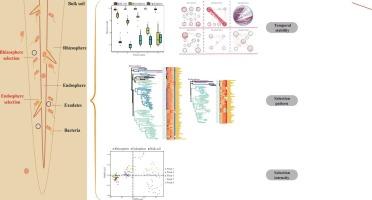大豆根际和内圈细菌群落组装时间格局的差异
IF 5
2区 农林科学
Q1 SOIL SCIENCE
引用次数: 0
摘要
两步选择模型是一种被广泛接受的关于根相关微生物群落机制的解释。然而,很少有研究从时间序列演替的角度对其进行解释。采用16S核糖体RNA (16S rRNA)测序技术分析了大豆根际和内圈细菌群落的时间序列演替模式。根际选择表现出时间上的差异,随着时间的推移,根际选择强度增加,导致根际与土壤群落之间的相似性在前9周从0.42下降到0.17。相比之下,内圈选择在早期很强,但逐渐减弱,内圈与土壤群落之间的相似性从0.10增加到0.12,内圈与根际群落之间的相似性从0.31增加到0.69。预测的群落功能也呈现出从块土到根际和内圈的梯度变化,进一步支持了选择效应。最具代表性的功能类群表现为趋化异养和有氧趋化异养。与生长阶段密切相关的操作分类单位(OTUs),主要来自变形菌门、酸性菌门和放线菌门,在根际的丰度呈下降趋势,而在内圈的丰度呈上升趋势。这些结果表明,根际选择和内圈选择都随植物生长而变化。根际选择是一个以抑制为主的逐渐增强的过程,而内球选择是一个以富集为主的逐渐减弱的过程。观察到的时间演替差异突出了根际和内圈选择的不同机制,为两步选择模型提供了重要的见解。本文章由计算机程序翻译,如有差异,请以英文原文为准。

Differences in temporal patterns of bacterial community assembly between soybean rhizosphere and endosphere
The two-step selection model is a widely accepted explanation of the mechanism of root-associated microbial communities. However, few studies have explained it from a time-series succession perspective. We analyzed the time-series succession patterns of bacterial communities in the rhizosphere and endosphere of soybeans using 16S ribosomal RNA (16S rRNA) sequencing. Rhizosphere selection showed temporal variation, with intensity increasing over time and leading to a decrease in the similarity between the rhizosphere and bulk soil communities from 0.42 to 0.17 during the first nine weeks. In contrast, endosphere selection was strong in the early stage but gradually weakening — with similarities between endosphere and bulk soil communities increasing from 0.10 to 0.12, and between endosphere and rhizosphere communities from 0.31 to 0.69. Predicted community functions also showed a gradient shift from bulk soil to rhizosphere and endosphere, further supporting the selection effect. The most representative functional taxa were those exhibiting chemoheterotrophy and aerobic chemoheterotrophy. Operational Taxonomic Units (OTUs) strongly associated with the growth stages, primarily from Proteobacteria, Acidobacteria, and Actinobacteria, showed decreasing abundance in the rhizosphere but increasing abundance in the endosphere. These results indicate that both rhizosphere selection and endosphere selection vary with plant growth. Rhizosphere selection is a gradually strengthening process dominated by inhibition, while endosphere selection is a gradually weakening process dominated by enrichment. The observed differences in temporal succession highlight distinct mechanisms of rhizosphere and endosphere selection, providing important insights into the two-step selection model.
求助全文
通过发布文献求助,成功后即可免费获取论文全文。
去求助
来源期刊

Applied Soil Ecology
农林科学-土壤科学
CiteScore
9.70
自引率
4.20%
发文量
363
审稿时长
5.3 months
期刊介绍:
Applied Soil Ecology addresses the role of soil organisms and their interactions in relation to: sustainability and productivity, nutrient cycling and other soil processes, the maintenance of soil functions, the impact of human activities on soil ecosystems and bio(techno)logical control of soil-inhabiting pests, diseases and weeds.
 求助内容:
求助内容: 应助结果提醒方式:
应助结果提醒方式:


